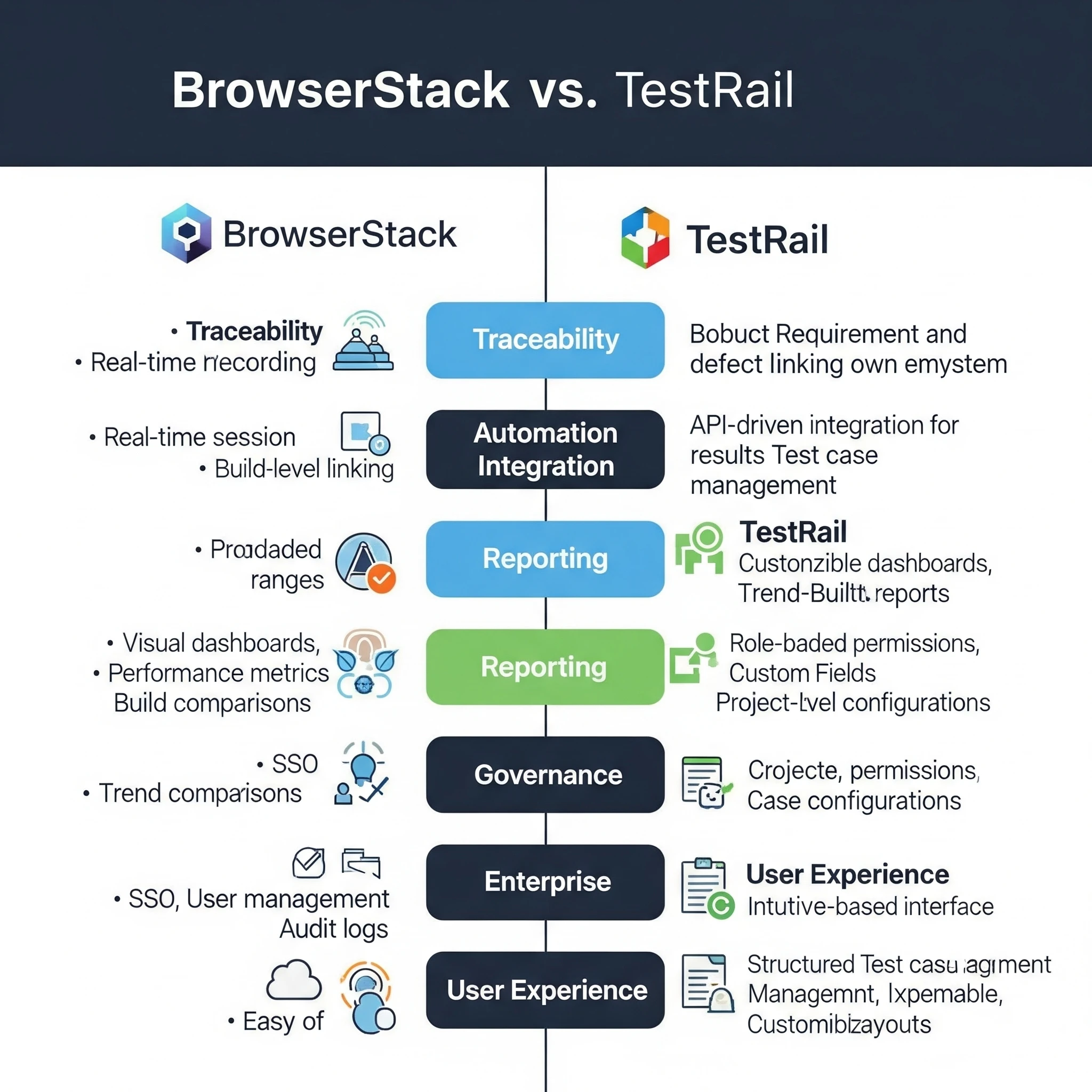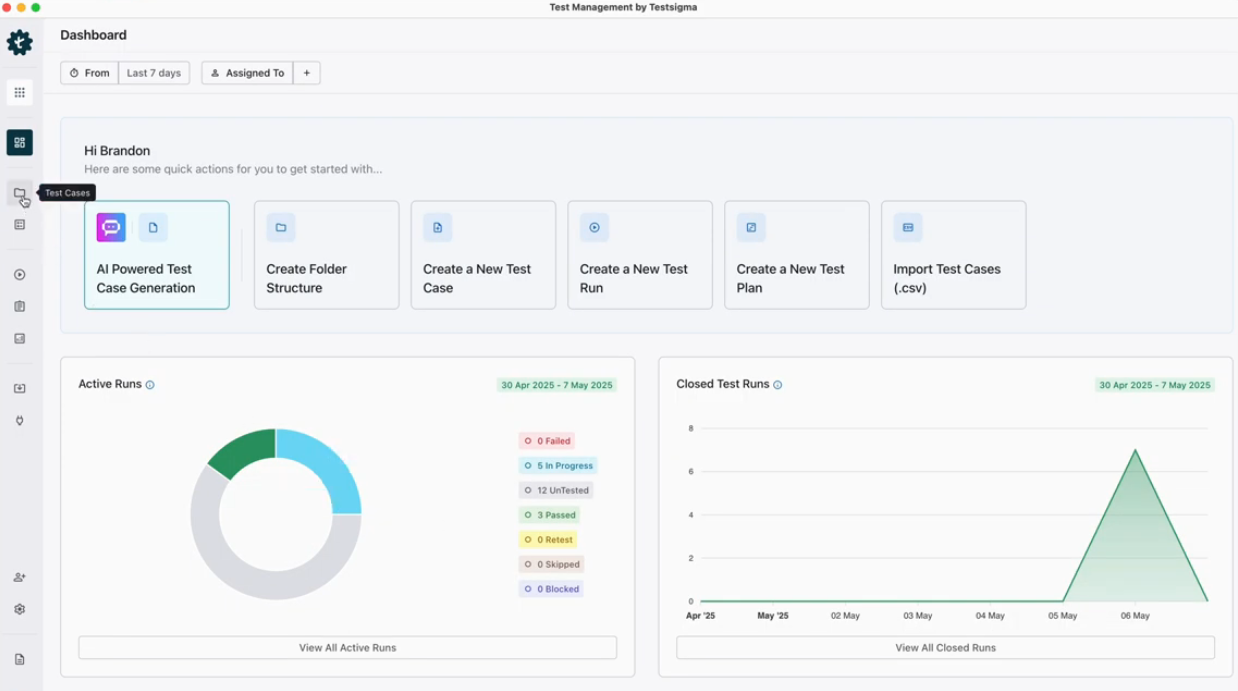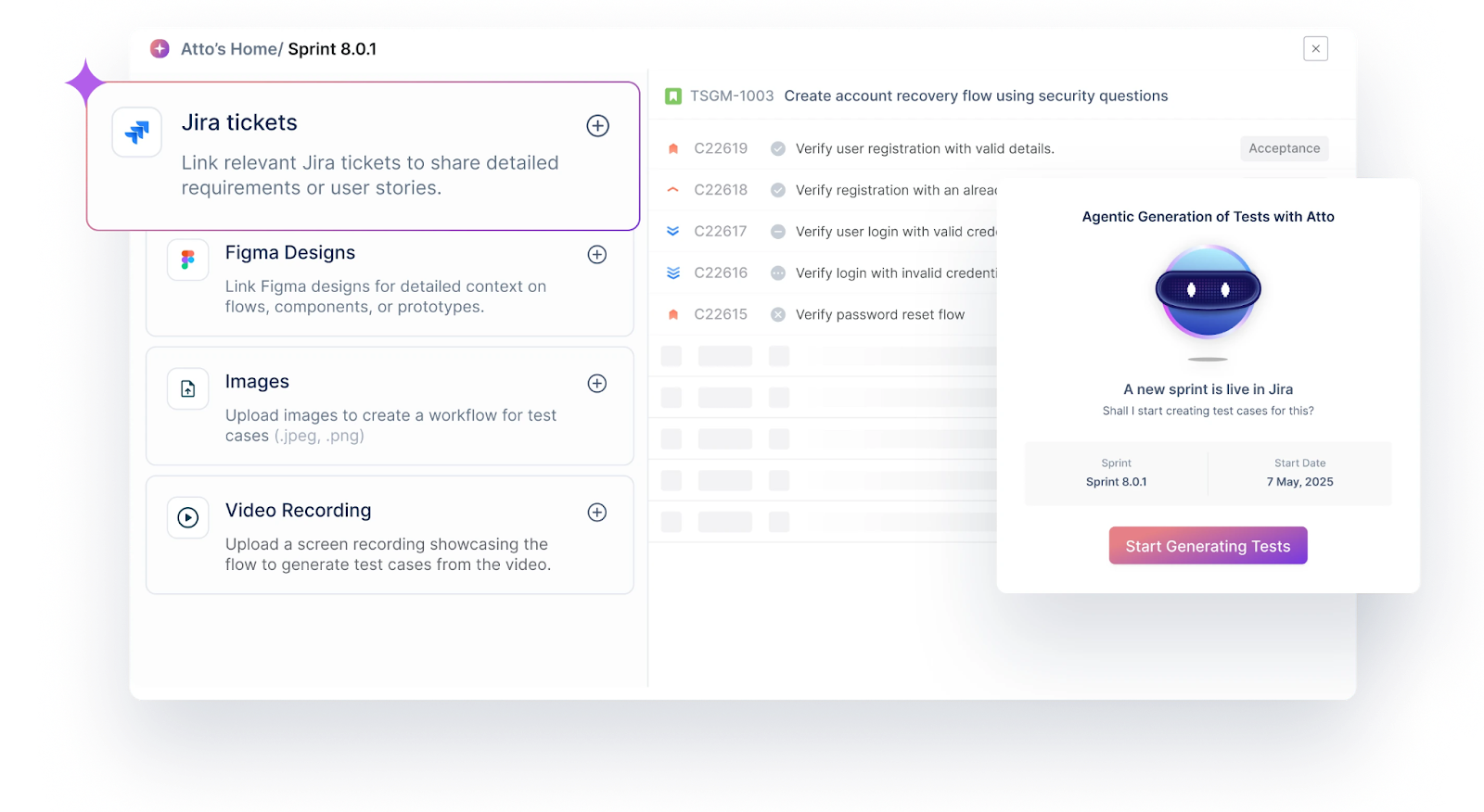Table Of Contents
- 1 Overview
- 2 What is BrowserStack Test Management?
- 3 What is TestRail?
- 4 BrowserStack vs TestRail: Detailed Comparison
- 5 Direct feature tradeoffs: BrowserStack vs TestRail
- 6 Which Should You Choose: BrowserStack Test Management Vs. TestRail
- 7 Test Management Alternative for BrowserStack Test Management and TestRail
- 8 Conclusion
- 9 FAQs
Overview
BrowserStack Test Management
BrowserStack Test Management is a modern test management tool within the BrowserStack ecosystem. It helps QA teams plan, manage, and execute manual and automated tests in one place while providing AI-assisted test case generation, reporting, and traceability.
TestRail
TestRail is a mature, widely used test management software trusted by QA teams. It allows teams to organize test cases, run test plans, track results, and integrate with issue trackers for structured and flexible testing workflows.
What to Choose
Choose BrowserStack Test Management if your team already uses BrowserStack for device or browser testing and wants tighter integration, faster debugging, and AI-assisted test creation. Pick TestRail if you need a stable, flexible tool that handles multiple OS, browsers, or locales, supports on-prem deployment, and offers proven approval and versioning workflows.
Choosing a test management tool can be confusing, especially when it’s BrowserStack vs TestRail. Both are widely used, but each works best in different situations. Whether you handle manual tests, automated runs, or cross-browser testing, picking the right tool can save hours of effort.
In this blog, we break down BrowserStack Test Management vs TestRail, look at real-world use cases, and introduce a modern test management alternative that makes planning, executing, and reporting tests faster and smarter.
What is BrowserStack Test Management?
BrowserStack Test Management is a newer addition to the BrowserStack ecosystem. It is designed to help QA teams plan, organize, and run manual as well as automated tests in one single place. Instead of switching between multiple tools, it aims to give a unified test management software experience.
Key Features of BrowserStack Test Management
- AI-Driven Test Case Generation
Helps auto-generate test cases directly from Jira stories, requirement docs, or prompts. Saves manual effort.
- Duplicate Test Case Detection
Detects similar or duplicate test cases and suggests merging or removing them. Keeps the suite clean.
- Convert Manual to Low-Code Automation
You can convert manual test cases into low-code automated tests, reducing rework.
- Test Runs and Plans
Allows grouping of test runs into plans, selecting environments (like browsers or devices), and handling both manual and automated cases.
- Advanced Reporting & Debugging
Offers AI-powered failure categorization, flaky test detection, root cause analysis, and debugging with detailed logs.
- Custom Dashboards & Metrics
Let’s teams track test progress, monitor automation coverage, and visualize trends with dashboards.
- Jira Integration with Traceability
Two-way Jira sync links requirements, test cases, and defects. Status changes update both ways.
- Bulk Editing, Import & Versioning
Bulk updates, CSV/API import, version history, and custom fields are supported.
- Simple & Fast UI
Designed to reduce clicks and speed up navigation for testers.
- Requirement-Test-Defect Linking
Maintains traceability by connecting requirements, test cases, and bugs in one workflow.
- Scalable for Enterprises
Promises features like SSO, API access, and data retention policies for larger organizations.
Since BrowserStack Test Management is new, it may not yet have the depth or maturity of older test management tools like TestRail.
Also Read: BrowserStack alternatives
What is TestRail?
TestRail is a well-known, established test management software that has been used by QA teams worldwide for years. It provides a powerful interface for creating test cases, grouping them into suites, running test executions, and tracking results. Over time, TestRail has added features for integrations, reporting, APIs, configuration handling, and enterprise workflows like versioning and approval systems. TestRail is known for its strong structure, flexibility, and ability to handle testing across multiple releases, platforms, and teams.
Compare TestRail vs Testsigma!
Key Features of TestRail
- Test Case & Suite Organization
Lets you create test cases and arrange them in a clear hierarchy of suites and sections.
- Different Case Types & Templates
Supports multiple formats such as text cases, step-based, BDD style, or exploratory sessions.
- Test Runs & Plans
Allows grouping of test cases into runs and larger test plans to handle variations.
- Configuration Support
Run the same test across different OS, browsers, or locales without duplicating cases.
- Result Tracking & History
Let’s testers mark pass/fail, attach screenshots or comments, and maintain the history of runs.
- Reporting & Metrics
Built-in dashboards and reports for coverage, progress, and milestones.
- User Roles & Permissions
Role-based access control for giving different privileges to different team members.
- Test Data Parameterization
Define variables and datasets to reuse test cases with different inputs.
- Versioning & Approval (Enterprise)
Enterprise edition supports draft/review/approve workflows and version control.
- Defect Tracker Integration
Works with Jira, GitHub, and other issue trackers for linking test failures to bugs.
- API & Automation Import
Let’s you connect automation systems and push automated test results into runs.
- Notifications & Alerts
Email alerts, tagging, and comments to keep teams updated.
- Cloud & On-Prem Deployment
Can be used as a SaaS service or installed on-premises for more control.
- Plugins & Extensibility
A plugin ecosystem and APIs make it customizable for different workflows.
TestRail is mostly trusted for its maturity, flexibility, and stability in test management.
Also Read: Testrail alternatives
BrowserStack Vs TestRail: Detailed Comparison
| Feature | BrowserStack Test Management | TestRail |
| Maturity | Newer tool, still growing. | Well-established, trusted for years. |
| Test Case Creation | AI-assisted authoring, deduplication, bulk edits, and custom fields. | Hierarchical suites, flexible templates, and versioning (Available in the enterprise version). |
| Test Runs & Plans | Combines manual and automation runs and environment configurations. | Strong test plan support with configuration handling. |
| Automation Integration | Deep integration with BrowserStack tools, CI/CD, and low-code automation conversion. | API-based integration, automated results import. |
| Reporting & Metrics | AI-based debugging, root cause analysis, quality gates, dashboards. | Rich reports, progress tracking, and milestone status. |
| Traceability | Two-way Jira sync, requirement-to-defect linkage. | Jira, GitHub, and other integrations for traceability. |
| Ease of Use | Modern, fewer clicks, AI support. | Mature but can feel heavier, with a longer learning curve. |
| Approval Workflows | Versioning is supported, and approvals are less emphasized. | Strong approval/versioning workflows (Enterprise edition only). |
| Enterprise Features | SSO, APIs, custom data policies. | Enterprise-ready, including on-prem deployment. |
| Parameterization | Limited mention. | Strong data parameterization support. |
| Deployment | Cloud only. | Cloud and on-premise options. |
| Pricing Transparency | Free plan with unlimited test cases and runs, Pro plan from $99/month, Enterprise pricing on request. | Professional plan from $38/user/month, Enterprise plan from $76/user/month. |
Also Read: Testsigma vs BrowserStack!
Direct Feature Tradeoffs: BrowserStack Vs TestRail

- Traceability and Jira Sync
Both tools support Jira and defect linking. BrowserStack promotes two-way sync tightly integrated with its automation and execution logs; TestRail offers mature two-way integrations and more ecosystem connectors.
- Automation Integration and CI/CD
BrowserStack provides deep native links to BrowserStack automation and device runs. TestRail relies on robust APIs that work with many CI systems and custom automation frameworks.
- Reporting and Analytics
BrowserStack focuses on AI-driven failure grouping, flaky detection, and quick debugging context. TestRail provides a wide set of built-in reports, milestone tracking, and longer-term trend dashboards.
- Enterprise Governance and Compliance
TestRail has stronger built-in governance capabilities and on-prem options. BrowserStack is moving toward enterprise capabilities but is primarily cloud-centric.
- User Experience and Day-to-Day Speed
BrowserStack aims for faster, simpler workflows with AI help for manual testers. TestRail offers powerful structure and control that can be more productive once teams invest time in setup.
Which Should You Choose: BrowserStack Test Management Vs. TestRail
BrowserStack Test Management is a good choice if your team is already using BrowserStack for device or browser testing. It gives you tighter integration, faster debugging, and fewer tools to juggle. Its AI-driven features and modern UI make setup easy and test case authoring faster, which is handy for smaller teams or those who want less manual effort.
TestRail works better if your testing involves multiple OS, browsers, or locales, or if you need test data parameterization. It is also a safer option for companies that need on-prem deployment, approval workflows, or strict compliance. With its maturity and stability, TestRail suits teams that prefer structure, configurability, and proven workflows.
Test Management Alternative for BrowserStack Test Management and TestRail

While BrowserStack Test Management and TestRail are both strong tools, many teams start looking for alternatives when they want faster setup, more automation, or modern AI-powered support. Legacy tools often require too much manual effort, multiple add-ons, or switching between systems. That’s where Test Management by Testsigma stands out as a smarter alternative.
Test Management by Testsigma is a unified test management tool powered by Agentic AI. It brings together everything a tester needs in one place, including planning, test case creation, execution, reporting, and integrations. Specialized AI agents handle most of the heavy lifting, from sprint planning to bug reporting, so testers spend less time on repetitive tasks and more time on quality. It supports end-to-end testing across web, mobile, APIs, and enterprise systems like SAP and Salesforce, making test management almost 10x faster.
Why Test Management by Testsigma is the best modern TMS:
- Agentic Test Management with AI Agents
Atto, the AI coworker, runs specialized agents:
- Sprint Planner: Starts test planning as soon as a sprint begins
- Generator: Creates test cases instantly from Jira, Figma, images, videos, or prompts
- Runner: Executes tests across environments
- Bug Reporter: Generates detailed bug reports automatically

Testers can pause, refine, or re-run these agents so results match real-world scenarios, making test maintenance easy without large teams.
- Set Up in 2 Minutes
Start testing right away without long onboarding.
- Unified Test Management
Manage manual, exploratory, and automated tests in one place. No need to switch tabs or rely on spreadsheets.
- Clean UI and Intuitive Workflows
Built for speed and simplicity, so even new users can pick it up quickly.
- Native Jira Integration
Two-way Jira sync for requirements traceability. Works with popular CI/CD tools like Jenkins, GitHub, GitLab, and Azure DevOps.
- Affordable Pricing
Core features are free forever. Paid plans start at just $14/user/month, much lower than most legacy tools.
- Self-Healing Test Maintenance
AI automatically detects application changes and fixes scripts, preventing tests from breaking and reducing rework.
Conclusion
There is no one-size-fits-all answer in the BrowserStack vs TestRail debate. Choose BrowserStack Test Management if you already rely on BrowserStack and want tight integration with automated and manual testing. Pick TestRail if you need a mature, stable tool with advanced workflows, multiple configurations, or on-prem deployment. For teams looking for speed, AI assistance, and a unified experience, Test Management by Testsigma is a modern alternative that simplifies test planning, execution, and reporting across web, mobile, APIs, and ERP systems.
FAQs
No, neither is strictly better. BrowserStack Test Management is newer and focuses on AI features and BrowserStack integration, while TestRail is mature, stable, and more flexible for complex workflows.
The main difference is maturity and focus. BrowserStack Test Management is cloud-only, AI-driven, and tightly integrated with BrowserStack products. TestRail is older, supports on-prem deployment, and offers advanced workflows like approval and versioning.
Yes, migration is possible but not automatic. You can import test cases using CSV or APIs, though some configurations and workflows may need to be recreated.
TestRail is usually more affordable for small teams, starting at $38 per user per month. BrowserStack’s Pro plan starts at $99, though its free plan includes unlimited test cases and runs.
Yes, both tools support automation testing. BrowserStack offers tighter integration with its own automation tools, while TestRail relies on APIs to import automation results.


